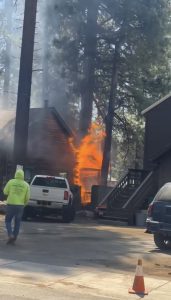The Steamers of D.L. Bliss
In every aspect of Lake Tahoe’s early development, the name Bliss played a prominent role.
Duane L. Bliss was the patriarch of a family empire devoted to the harvest, transport and processing of timber in and around the Tahoe Basin. His timely arrival in the Sierra enabled him to acquire vast tracts of mostly old-growth timberland at a fraction of their later value and thus to dominate all aspects of the high-altitude economy on which the deep-shaft mining of Virginia City’s Comstock Lode depended.

From the moment silver was discovered near what would become Virginia City, commerce within the Tahoe Basin and on its surrounding hillsides was based on trees. In the developing mining economy, trees played two essential roles. First, they could be bucked up and burned for fuel – an important asset in a region devoid of other natural fuel sources. Second, Tahoe’s vast sylvan resource could be milled into the massive timbers needed to reinforce the mineshafts of Virginia City.
The systematic harvesting of trees required transport to a central staging area for processing. The trees that were the basis of Bliss’s potential financial empire first had to be cut down, relieved of their limbs and skidded to the lakeshore using teams of oxen. And with no passable roads connecting the outlying camps with Glenbrook Bay, delivering trees to the mills would also have to include travel by water.
Bliss chose Glenbrook as the site of three mills, where timber felled within the Basin was brought for milling. Lumber exiting the Bliss mills was loaded aboard rail cars waiting at the lakeward terminus of a short-line railroad, completed in the early summer of 1875. By means of a series of switchbacks this road, known as the Lake Tahoe Narrow Gauge Railroad, was able to ascend the steep hillside to its summit, where its cargo was discharged, continuing to the floor of the Carson Valley via flume.
The process of turning standing timber into stovewood was simple and methodical, and though Bliss had no background in things marine, he soon acquired a steam-powered vessel previously owned by transportation tycoon Ben Holladay and used to tow large floating “booms” of logs to Glenbrook for milling. Known as the EMERALD, the boat’s graceful 55-foot hull was more tastefully appointed than her purpose suggested, and she carried her owners and their guests on marine excursions as well as towing logs to the Bliss mills.
But business was booming and in 1875, in need of a second boat, Bliss commissioned an 80-foot, steel-hulled vessel to be built by the shipyard of Harlan, Hollingsworth & Co. of Wilmington, Delaware. The new Steamer METEOR, acclaimed as the fastest boat in the world at the time of her launch on August 27, 1876, was a sleek 80-foot hull that could travel at 20 knots, and had the distinction of carrying President Rutherford B. Hayes in 1879.

For the first 20 years of her life, METEOR was commanded by Captain Ernest John Pomin, one of four nautical brothers who had found their way to Lake Tahoe from the war-torn province of Alsace-Lorraine in central Europe in the late 1860s. Bliss had discovered the skill and dependability of Captain Pomin and his two older brothers, Fredric L. (“Fritz”) and Joachim Henry (“Cap Joe”), and eventually employed all three aboard his Steamers.
As the 19th Century concluded, Bliss’ plans to diversify his business interests with the construction of a grand hotel near Tahoe City included one last Steamer, a toothpick-beamed vessel nearly 169 feet long and with a capacity of 200 passengers. In 1896 Captain Ernest John Pomin was appointed to pilot the new Steamer, which was christened the TAHOE, and when Captain Pomin assumed the helm of the TAHOE, Captain Edmund Hunkin, a native of England who had arrived at Tahoe in 1899, was elevated to the position of METEOR’s Captain. John Paul Cranmer became Engineer, with Pete Hawkins stoking. Following Captain Pomin’s accidental death by drowning in 1919, Hunkin replaced him as Captain of the TAHOE, a position he held until his own death from a heart attack in 1931.
Captain Henry Rose, a Pilot Hill native who was the son of a Gold Rush 49er, replaced Hunkin. Rose had worked as a Tahoe market fisherman before taking on the Captaincy of the Tahoe Tavern’s launch WILD GOOSE in 1913, and continued to serve as the Steamer TAHOE’s Captain until 1932, when an incident in which Rose was blameless nevertheless resulted in his dismissal.

Serving as Captain of the TAHOE in her final years of operation was Captain George Mawdsley, who resigned in February 1935 in light of the discontinuance of the Steamers’ regular operation. The Bliss family’s loss of the mail contract to D.M. Brodehl and his gas-powered cruiser MARIAN B meant that the TAHOE could no longer operate at a profit. Ernest Henry “Tahoe City Ernie” Pomin stepped in to finish out the regular winter season of the NEVADA, but the era of Tahoe’s Steamers was virtually over, and only the disposition of the Bliss family’s surviving ships remained to be decided.
During the later years of the 1930s the steamer TAHOE sat tied to the SP pier in Tahoe City, her glorious rein only a memory. Tahoe residents and “vacationists” vandalized the once-proud boat, stealing her brass hardware, scribbling indignities on her bulkheads and even using her interior as a toilet. She had been offered for sale for the value of her scrap metal, but the Bliss family, who had bought her back from the LTR&TCo in a moment of sentiment, rejected the only offer, making plans instead to scuttle their flagship in Glenbrook Bay, where she could rest near the scene of her past glory.
By the mid-1930s, the TAHOE, the METEOR and the NEVADA had all been removed from service, and on April 21, 1939 the METEOR was scuttled mid-lake while three of her former crew members observed in silence. On August 29, 1940 the TAHOE was towed to a point near Glenbrook, where she met the same fate, and in October 1940 the NEVADA was set afire off Dollar Point and sunk, ending seven decades during which steam provided the motive power for most of the Lake’s commercial and recreational boating.
ABOUT THE AUTHOR: Carol Van Etten is a long-time student and author of Tahoe history. By conducting Oral History interviews and archival research for the North Lake Tahoe Historical Society and the Tahoe Maritime Museum, she has contributed much to our knowledge of Tahoe in earlier times.
Find more Tahoe HISTORY at THE Gatekeepers Museum, NLTHS, Tahoe City, www.northtahoemuseums.org
Support Local Journalism


Support Local Journalism
Readers around Lake Tahoe, Truckee, and beyond make the Sierra Sun's work possible. Your financial contribution supports our efforts to deliver quality, locally relevant journalism.
Now more than ever, your support is critical to help us keep our community informed about the evolving coronavirus pandemic and the impact it is having locally. Every contribution, however large or small, will make a difference.
Your donation will help us continue to cover COVID-19 and our other vital local news.








